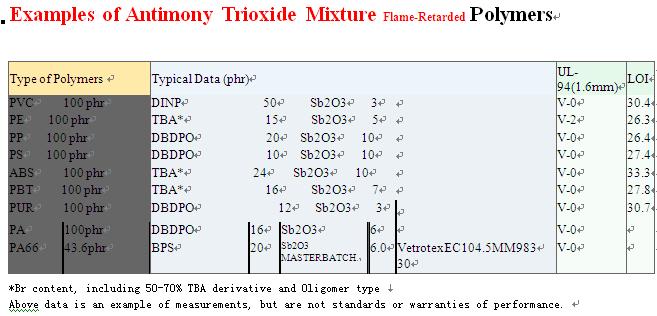Antimony trioxide
CAS Nos: 1309-64-4 - Antimony oxide; 1317-98-2 - Valentinite; 12412-52-1 - Senarmontite
Chem. Abstr. Name: Antimony oxide
Antimony trisulfide
CAS Nos: 1345-04-6 - Antimony sulfide; 1317-86-8 - Stibnite
Chem. Abstr. Name: Antimony sulfide
5. Summary of Data Reported and Evaluation
5.1 Exposure data
Antimony trioxide is produced from stibnite ores (antimony trisulfide) or as a by-product of lead smelting and production. It is used mainly in fire-retardant formulations for plastics, rubbers, textiles, paper and paints. It is also used as an additive in glass and ceramic products and as a catalyst in the chemical industry. Occupational exposure may occur during mining, processing and smelting of antimony ores, in glass and ceramics production, and during the manufacture and use of products containing antimony trioxide.
Antimony trisulfide is used in the production of explosives, pigments, antimony salts and ruby glass. Occupational exposure may occur during these processes and also during the mining, processing and smelting of ores containing antimony trisulfide.
5.2 Experimental carcinogenicity data
Antimony trioxide was tested for carcinogenicity by inhalation exposure in male and female rats of one strain and in female rats of another strain, producing a significant increase in the incidence of lung tumours (scirrhous and squamous- cell carcinomas and bronchioloalveolar tumours) in females in both studies. No lung tumour was seen in male rats.
Antimony ore concentrate (mainly antimony trisulfide) was tested for carcinogenicity by inhalation exposure in male and female rats of one strain, producing a significant increase in the incidence of lung tumours (scirrhous and squamous-cell carcinomas and bronchioloalveolar tumours) in females. No lung tumour was seen in males.
5.3 Human carcinogenicity data
The available data were inconclusive.
5.4 Other relevant data
Antimony trioxide causes pneumoconiosis in humans. One study of women exposed to dusts containing metallic antimony, antimony trioxide and antimony pentasulfide suggested that they may have had an excess incidence of premature births and spontaneous abortions and that their children's growth may have been retarded.
Antimony trioxide induced DNA damage in bacteria.
5.5 Evaluation
There is inadequate evidence for the carcinogenicity of antimony trioxide and antimony trisulfide in humans.
There is sufficient evidence for the carcinogenicity of antimony trioxide in experimental animals.
There is limited evidence for the carcinogenicity of antimony trisulfide in experimental animals.
**********************
DONGGUAN JIEFU FLAME-RETARDED MATERIALS CO.,LTD
Sam Xu
Tel: 86-755-83474911
Fax: 86-755-83474980
Mobile:13929211059
E-mail: xubiao_1996(at)hotmail.com samjiefu(at)gmail.com
Add: jiefu industrial park shuiping industrail district dalang town dongguan GD,P.R.C
blog:http://antimony-trioxide.blogspot.com
website:http://www.jiefu.com








0 comment:
Post a Comment